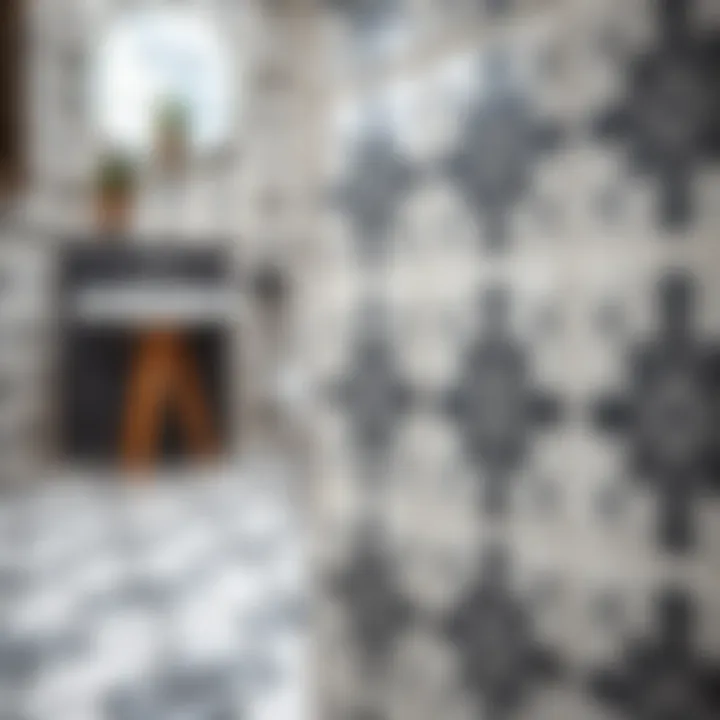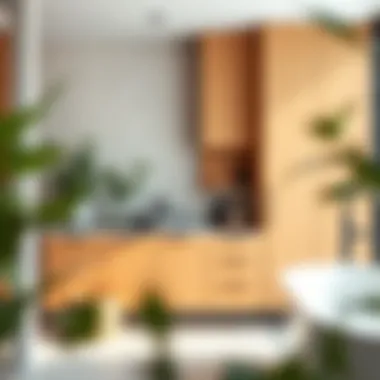Exploring Bathroom Materials: A Comprehensive Guide


Intro
In the realm of home improvement, the quest for perfect bathroom materials stands at the forefront of many homeowner’s aspirations. The bathroom is often regarded as a sanctuary, a personal retreat where we wash away the stress of the day. But what constitutes the ideal bathroom? The answer lies not only in how it looks but also in what it’s made of. With varying materials available, making informed choices can seem daunting, especially when considering factors such as durability, aesthetic appeal, and maintenance.
As we dive deeper into this guide, we will explore a variety of materials that can transform the dynamics of your space. From the sleek lines of ceramic tiles to the warm embrace of natural wood, each material has unique attributes that cater to different tastes and needs. Furthermore, we’ll shine a light on local sourcing, which not only supports community businesses but often brings you better accessibility to sustainable options.
Through this narrative, get ready to equip yourself with the insights needed to make choices that reflect not just functionality but also your personal style. It’s all about creating a bathroom that's not just pleasing to the eye but also practical.
"In today's designs, it's about harmonizing beauty and utility, ensuring that each material tells a story."
In the following sections, we will address key trends and practical buying guides that will help you on your journey to achieving a bathroom that is not only functional but also a true reflection of your style.
Intro to Bathroom Materials
In any home, the bathroom represents a unique convergence of functionality and aesthetics. When exploring bathroom materials, the choices one makes can greatly influence not just the beauty of the space, but also how it performs over time.
The Importance of Choosing the Right Materials
Selecting suitable materials for your bathroom goes beyond mere appearances. Consider the environmental condition of the area: moisture levels can wreak havoc on certain substances. Materials like ceramic tiles or vinyl are popular for their ability to withstand humidity and ease of maintenance. Choosing wisely ensures longevity and less frequent repairs or replacements, thus making your investment worthwhile.
Beyond durability, there’s the aspect of style to factor in. A wrong choice can throw off the balance of your design. For example, while oak might impart warmth, it isn’t the best suited for wet conditions. The ideal choice will harmonize functionality with visual appeal, creating a sanctuary that's both practical and beautiful.
Common Challenges in Material Selection
Material selection isn't without its hurdles. Homeowners often grapple with several challenges:
- Understanding Material Properties: Different materials have unique characteristics. It's not just about looks; vinyl could be considered cost-efficient yet lacks the depth of natural stone.
- Balancing Budget with Quality: A tight budget can steer decisions towards lower-quality materials, leading to further costs down the line due to repairs.
- Compatibility with Existing Decor: When updating a bathroom, harmonizing new materials with existing elements can often feel like putting together a jigsaw puzzle without all the pieces. What looks good in isolation may clash when integrated into a larger design.
Furthermore, seasonal changes might also figure into your choices; colder months could influence how certain surfaces feel against bare skin. All these factors can make the already daunting task of selecting bathroom materials even more intimidating.
"Choosing the right bathroom material is less about finding what looks good, and more about ensuring your selections withstand the test of time and wear."
Navigating these challenges requires a blend of knowledge and insight. Understanding each material's strengths and weaknesses, evaluating your own priorities, and even seeking advice from professionals can help lighten the load. Consider your lifestyle; are you a busy parent needing durability, or do you fancy a spa-like retreat? Your needs largely dictate the path ahead in this material journey. In the ensuing sections, we'll delve deeper into the types of materials available and how to manage the selection process effectively, ensuring a bathroom you’ll enjoy for years on end.
Types of Bathroom Materials
Understanding the different types of bathroom materials is crucial for creating a space that not only looks good but stands the test of time. This section aims to explore the options you have, each with its unique strengths and pitfalls. Selecting the right materials is more than an aesthetic choice; it impacts durability, maintenance, and ultimately, how satisfied you will be with your bathroom over the years.
Bathroom materials can influence functionality and comfort while reflecting personal style. The choices include tiles, stones, and more unconventional materials like glass and vinyl. By weighing the benefits and challenges of each, homeowners and designers can make informed decisions that align with their visions and practical needs.
Ceramic Tiles: Versatile and Durable
Ceramic tiles are a staple in bathroom design, largely due to their versatility and durability. They come in a wide array of colors, patterns, and sizes, making it easy to customize your space. This flexibility allows for creative floor and wall designs—think intricate mosaics in a shower or large format tiles that can make a smaller bathroom feel expansive.
Ceramic tiles are also resistant to moisture and stains, which makes them ideal for a bathroom setting. This resistance means they can often be cleaned with just soap and water, simplifying maintenance. However, homeowners should be aware that the grout used between tiles can collect mildew if not properly cared for, requiring additional upkeep.
Natural Stone: Aesthetic Appeal and Longevity
Natural stone offers an unmatched aesthetic and durability, making it a highly desired option for bathrooms. Each type brings its own qualities to the table, whether you're going for elegance or rustic charm.


Marble
Marble is widely admired for its luxurious appearance and unique veining. Its iridescent quality can transform any bathroom into a sanctuary of elegance. The key characteristic of marble is its beauty—each piece is one-of-a-kind, which appeals to those looking to make a statement.
However, marble’s beauty comes at a cost. It's porous, meaning it can stain easily if spills aren’t wiped up promptly. Regular sealing can help protect it, but this adds an extra layer of maintenance that homeowners should consider. In summary, the beauty of marble can elevate bath spaces but comes with its own set of responsibilities regarding care.
Granite
Granite is renowned for its durability and resistance to scratches, making it one of the tougher materials available. This stone is often chosen for countertops but can also be used for flooring and walls. Its varied colors and patterns allow for flexibility in design, and it complements a variety of styles from modern to traditional.
The main advantage of granite is its resilience; it can withstand the rigors of daily use without showing wear. A downside, however, is that it generally requires professional installation due to its weight and the need for precise cutting. Additionally, similar to marble, granite should be sealed to maintain its water and stain resistance, which adds another layer of consideration for potential buyers.
Slate
Slate is another natural stone option that offers a distinctive look and feel. Its texture and earthy colors can provide a cozy, rustic ambiance, appealing to those who appreciate organic designs. Slate is particularly praised for its slip resistance, especially when used on bathroom floors.
However, slate can be a bit tricky to maintain. Its porous nature means it can absorb moisture, leading to potential staining if not properly sealed. Additionally, some slate tiles may be prone to chipping or cracking if subjected to heavy forces, so careful handling during installation and cleaning is advised.
Glass: Modern and Elegant
Glass has become a modern favorite due to its airy feel and ability to create the illusion of space. It’s commonly used for shower doors, tiles, and even countertops. Glass can reflect light, making a room feel brighter and more open.
While glass is easy to maintain and resistant to moisture, it can be somewhat fragile and prone to scratches if not regularly tended to. Additionally, some find glass requires more frequent cleaning to maintain that sparkling look, which can be a drawback for those who prefer low-maintenance solutions.
Vinyl: Cost-Effective and Easy to Install
Vinyl flooring is known for being budget-friendly and easy to install, making it an attractive option for many homeowners. Available in sheets, tiles, or planks, vinyl can mimic the look of wood, stone, or tile, allowing for diverse design options.
One of the biggest benefits of vinyl is its water resistance, making it suitable for bathrooms that experience high humidity. However, some vinyl products may not have the same longevity as natural materials. It can wear over time, particularly in high-traffic areas, so while it's low-cost upfront, it may require replacement sooner than more durable materials.
Wood: Warmth and Style
Wood may seem an unusual pick for bathrooms, but it brings warmth and a touch of nature that can make a space feel inviting. Whether stained or left in its natural form, wood can provide a rustic charm.
However, wood does have its challenges—primarily its susceptibility to moisture and warping. If using wood, it's essential to select species that are more water-resistant, like teak or cedar, and to ensure proper sealing and ventilation to ward off any rot or mold. While less common, a well-executed wooden bathroom can become a stunning focal point if done thoughtfully.
Sourcing Bathroom Materials Nearby
When embarking on a bathroom renovation or a new build, sourcing materials nearby can feel like a daunting task. However, it’s of utmost importance for several reasons. First off, local sourcing significantly reduces the carbon footprint associated with transporting materials across long distances. Moreover, obtaining materials locally often means you’re more likely to find products that are suited to the local climate, an important consideration that can affect durability and performance. It also opens up avenues for you to engage directly with suppliers who can offer helpful advice and insights you might not get online.
Identifying Local Suppliers
To begin your search, start by identifying local suppliers. A quick online search or a visit to a local hardware store can reveal a plethora of options. Don’t just stick to the big-box retailers; consider exploring specialty stores that may offer unique materials like reclaimed wood or artisanal tiles. Local suppliers often have a keen understanding of what works well in your region. Visiting a local merchant in person gives you the chance to inspect materials, discover unexpected finds, and even negotiate better deals.
"While shopping online offers convenience, it can’t replace the immediacy and engagement of walking into a local shop."
You can also check out community bulletin boards, both physical and virtual, to find out what others in your area are recommending.
Evaluating Material Quality from Local Stores
Once you’ve narrowed down your list of potential suppliers, it’s time to evaluate the quality of the materials. Take a close look at the products available in-store. Pay attention to their finish, durability, and craftsmanship. This can be difficult to assess through images online, where lighting and angles can be misleading. Pro-tip: if possible, bring along a sample or photo of your existing decor to compare colors and textures.


Don’t hesitate to ask questions! Suppliers can offer guidance on how different materials stand up to wear and tear, moisture, and daily use. For instance, if you're considering using bamboo for cabinetry, find out whether it's treated for water-resistance. Such fine details make all the difference in the long run.
Cost Considerations of Local Sourcing
Cost is often a deciding factor when choosing materials, and local sourcing presents various financial implications. Generally, purchasing locally can save on shipping costs and reduce lead times, which is especially beneficial if you’re on a tight schedule. However, beware of the potentially higher price tags that can accompany specialized or unique materials. Sometimes, it’s simply not feasible to go for premium options if they strain the budget.
To ensure you’re making a sound financial decision, take the time to compare prices among different local suppliers. Keeping a close eye on sales or seasonal discounts can reveal hidden costs and savings. Additionally, think about the long-term investments; spending a bit more now on high-quality materials can save you money by reducing future maintenance costs. Remember, when it comes to renovations, quality doesn’t always come cheap, but it often pays off in the long run.
Factors Influencing Material Selection
Choosing the right materials for your bathroom is not just about aesthetics; it's a careful dance of various factors that inform the decision-making process. Homeowners and designers alike need to navigate durability, aesthetic compatibility, and a growing emphasis on sustainability.
Durability and Maintenance Requirements
Durability plays a pivotal role in selecting bathroom materials because this space is subject to unique challenges, like moisture and temperature fluctuations. Materials that don't withstand these conditions can lead to significant problems down the line, both in structure and appearance.
For instance, porcelain tiles are stout and resistant to water, making them an excellent choice for flooring. Conversely, untreated wood is prone to warping and splitting from humidity, which is often a deal-breaker. Homeowners must think about how much maintenance they’re willing to put in. A high-maintenance material like natural stone may require sealing and special cleaning solutions, while vinyl can usually just be swept and mopped with standard household cleaners.
"Durability doesn't just keep your bathroom looking fresh; it saves time and money on repairs down the road."
Aesthetic Compatibility with Current Decor
When selecting bathroom materials, compatibility with existing decor is an essential aspect not to overlook. The total look of the space is a reflection of personality and style. If you're redoing the bathroom in a modern minimalist design, glass and sleek ceramics might be the way to go. Alternatively, if the vibe leans more traditional or rustic, natural stone or wooden accents may resonate better.
Finding a balance here is key. A material that clashes with the current color palette or design theme can make the entire space feel disjointed. Consider the overall vision: Does it flow? Does it evoke the right emotion? A well-coordinated style can elevate the bathroom from merely functional to a serene and inviting retreat.
Sustainability and Environmental Impact
In today's world, sustainability is increasingly dictating consumer choices, especially in home improvement. The environmental impact of materials should be a top consideration for anyone looking to snazz up their bathrooms. Using eco-friendly materials not only reduces your carbon footprint but also contributes to a healthier indoor environment.
For example, bamboo flooring is a sustainable option that combines beauty and resilience, while also being less harmful to the environment than traditional hardwoods. Furthermore, recycled materials can add a unique twist to your design while promoting eco-friendliness.
Making informed choices about sourcing and material composition allows homeowners to take a small but meaningful step toward sustainability. By prioritizing environmentally-responsible materials, we can relish in our beautiful bathrooms while also caring for the planet.
In summary, the choice of materials in a bathroom is a multifaceted decision that involves evaluating durability, aesthetic appeal, and ecological responsibility. Awareness of these factors can lead to a well-thought-out selection that meets both functional needs and personal values.
Installation Considerations
When it comes to bathroom materials, the installation process is as crucial as the materials themselves. The right installation not only contributes to the aesthetic value of the space but also affects how durable and functional the bathroom will be. Grasping the nuances of installation can prevent future headaches, ensuring that your beautiful choices stand the test of time.
DIY vs. Professional Installation
In the great debate of DIY versus hiring professionals for bathroom installation, both sides have their merits. Opting for a DIY approach may seem appealing. It can save money, and you can take pride in your handiwork. However, certain materials, particularly natural stone or intricate tile layouts, require a skilled hand. Mistakes can be expensive, leading to additional repair costs down the line.
- DIY:
- Professional Installation:
- Cost-effective: Avoiding labor cost can be tempting. If you're handy, why not?
- Personal Satisfaction: Completing a project on your own can be incredibly rewarding.
- Expertise: Professionals know the ins and outs of material and installation techniques.
- Time-saving: Let’s face it, a bathroom job can be lengthy when you’re learning on the go.
Ultimately, the choice boils down to your comfort level and the complexity of the materials selected for use. If you’re not sure, consulting with a professional can be a step in the right direction, guiding you whether to dive into the DIY pool or remain on the safe side of hiring help.


"A wise man does not lay a bridge to walk upon it, but knows what end leads to which path."
Tools Needed for Installation
If you've decided to roll up your sleeves, getting the right tools for your project is half the battle. No point in trying to drive nails with a wrench, right? The tools required can vary depending on the materials used, but here’s a general list to get you started:
- Basic Tools:
- Installation-Specific Tools:
- Safety Gear:
- Tape Measure: Always have this handy for precise measurements.
- Utility Knife: Perfect for cutting tiles or vinyl with accuracy and ease.
- Level: Ensuring everything is straight and in line is vital for aesthetics.
- Tile Cutter: If you're using ceramic or porcelain tiles, you'll need this to get clean cuts. A wet saw for larger tiles can save you lots of time too.
- Caulking Gun: Vital for sealing gaps and ensuring water doesn't seep into unwanted areas.
- Trowels and Sponges: Ideal for spreading adhesives or grouting.
- Gloves: Protect your hands when handling sharp tiles or heavy materials.
- Safety Goggles: Always a good idea when cutting or drilling, to keep those pebbles out of your eyes.
Whether you’re a seasoned DIYer or a beginner, having the right tools is essential for getting the job done well. The choice of materials, how you install them, and the tools you use can all dramatically influence the final appearance of your bathroom. With careful consideration, you can create a space that not only looks great but also functions perfectly for years to come.
Trends in Bathroom Material Design
Understanding the trends in bathroom material design is not merely for aesthetic gratification — it plays a significant role in enhancing functionality, sustainability, and overall value of the space. Current trends reflect a shift towards materials that are not only functional but also environmentally conscious. Homeowners and designers are increasingly looking for materials that embody both style and utility. The significance of these trends cannot be overstated; they’re shaping the future of bathroom design in ways that cater to modern demands and preferences.
Popular Color Palettes and Finishes
Color palettes in bathroom design have evolved beyond the traditional white and beige to encompass a wider array of shades and textures. Basil green, deep navy, and soft taupe can now be found gracing tiles and cabinetry, creating spaces that feel fresh and invigorating.
- Neutral Tones: Soft grays and beiges are still popular, offering a calm backdrop that allows fixtures and accents to shine.
- Bold Accents: Deep colors like forest green or navy blue, when applied as accent walls, could provide a dramatic contrast to lighter materials.
- Textured Finishes: Matte finishes are gaining traction. These create a more organic feel when compared to high-gloss options.
- Earthy Undertones: Natural colors, inspired by the outdoor landscapes, are making their way into bathrooms, bringing a sense of tranquility.
Ultimately, a harmonious blend of colors and finishes not only enhances the aesthetic appeal but also affects the perceived size and light of space. Combining these elements strategically allows a homeowner to create a unique ambiance while ensuring they resonate with current design trends.
Innovative Uses of Materials to Enhance Functionality
Functionality in bathroom design isn’t just about how well a space works; it’s about how materials contribute to daily use and maintenance. Innovative thinking in material use can lead to improved efficiency and ease in everyday tasks. Some noteworthy observations include:
- Self-Cleaning Surfaces: The introduction of self-cleaning tiles coated with nanotechnology provides an intuitive way to keep surfaces pristine, reducing the effort required for maintenance.
- Use of Recycled Materials: Many designers now incorporate recycled glass or reclaimed wood. These materials are not only eco-friendly, but they also tell a story, adding character to any bathroom.
- Modular and Customizable Designs: Modern materials enable customization. For instance, modular storage solutions adapted to fit specific needs address clutter, making bathrooms feel larger and more usable.
- Hydrophobic Coatings: Applying hydrophobic treatments to textiles like shower curtains or storage can dramatically reduce moisture retention, preventing mildew and extending the lifespan of fabrics.
In essence, the innovative application of materials contributes profoundly to the usability of bathroom spaces, making them more adaptable to the unique lifestyle of the user. The thoughtful integration of these trends not only enhances functionality but also embodies a commitment to sustainable and modern living.
"Trends in design are not merely trends; they’re reflections of our evolving relationship with space and nature."
For further reading on color trends and innovative material use, consider visiting Wikipedia or Britannica for authoritative insights.
The End
As we wrap up this comprehensive exploration of bathroom materials, it's clear that making savvy choices can have a substantial impact on both the aesthetic appeal and functionality of your space. Selecting the right materials goes beyond mere looks; it encompasses durability, maintenance, and how well the materials align with personal values, such as sustainability. Investing time in the selection process pays dividends in the long run, offering not just a visually pleasing space but one that withstands the test of time.
Recap of Important Considerations for Material Selection
When it comes to bathroom materials, several key considerations should stay front and center:
- Durability: Select materials that can handle moisture and everyday wear. For example, porcelain tiles and natural stone resist water and scratches, making them superb choices.
- Maintenance Needs: Some materials require more upkeep than others. While acrylic is easy to clean, natural stone might need sealing to maintain its luster.
- Aesthetic Appeal: Think about how the materials will fit with existing decor. A balance between personal taste and trendy styles will help in achieving a harmonious look.
- Environmental Impact: Keep sustainability in mind. Recycled or reclaimed materials not only add character but also minimize waste.
"Choosing the right materials can be the difference between a bathroom that ages gracefully and one that shows wear sooner than you’d like."
Encouragement for Informed Decision-Making
It’s not just about picking a tile or a faucet; it’s about crafting a vision for your bathroom that brings together form and function. Take the time to research different materials, visit local suppliers, and understand the pros and cons of each option. This way, you're not just following trends but setting a standard for a space that reflects your lifestyle and values. In the end, the best decisions stem from thoughtful consideration, leading to a bathroom experience that feels uniquely yours.
For further reading, you might find insights from resources such as Wikipedia or Britannica beneficial. Dive into forums like Reddit to hear firsthand experiences from homeowners and DIYers. With the right blend of information and inspiration, your bathroom remodel is only a thoughtful choice away.















